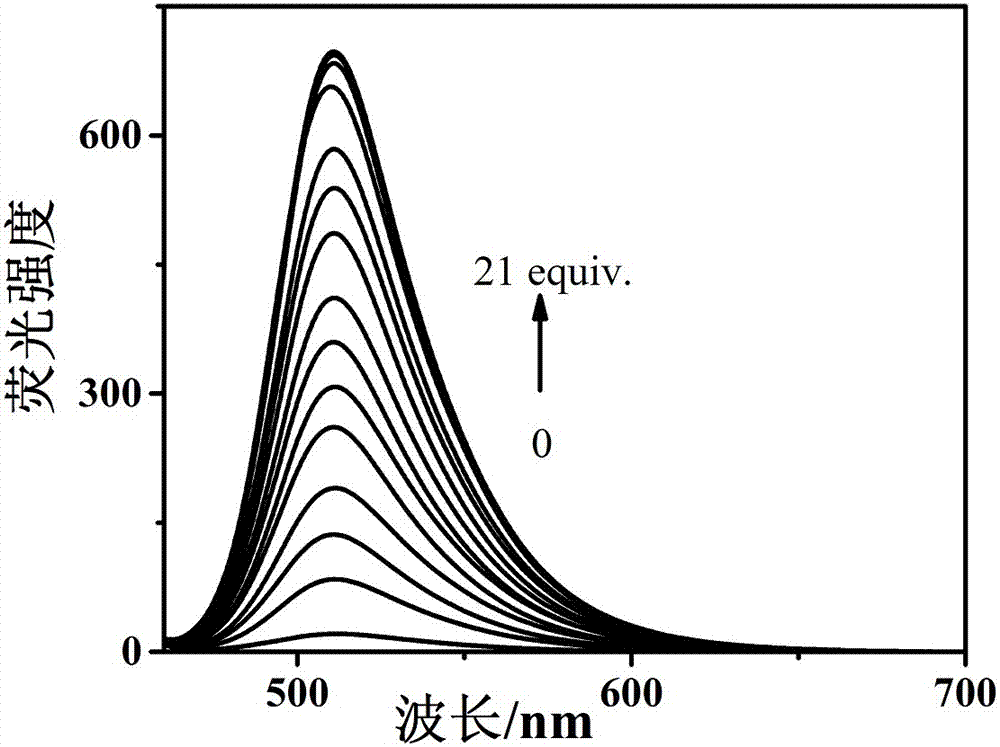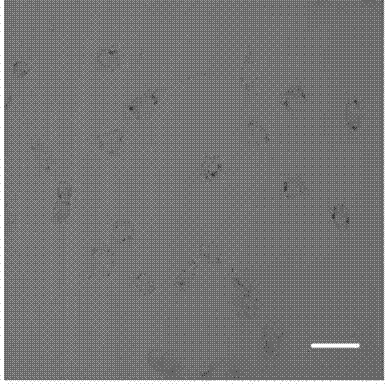Preparation and application of a hydrogen peroxide fluorescent probe compound
A fluorescent probe and hydrogen peroxide technology, applied in the field of fluorescent probes, can solve the problems of short response time, short hydrogen peroxide existence time, low selectivity, etc., and achieve the effects of fast response, low price and high sensitivity
- Summary
- Abstract
- Description
- Claims
- Application Information
AI Technical Summary
Problems solved by technology
Method used
Image
Examples
Embodiment 1
[0040] Embodiment 1, the synthesis of probe I
[0041] (a) Take 1.106g of 2,4-dihydroxybenzaldehyde and 0.816g of imidazole in a three-necked flask, protect it with nitrogen, add 1.3ml of cyclohexenone into the flask; add 6ml of tetrahydrofuran and 6ml of water into the flask , reacted at 25°C for 72 hours, then added 20 ml of 1M dilute hydrochloric acid, extracted the aqueous phase with ethyl acetate, evaporated the solvent, and used a mixed solvent of ethyl acetate and n-hexane with a volume ratio of 1:6 as the developing solvent, and the column layer Analysis and separation gave 0.46 g of pure product II. H NMR spectrum: 1 H NMR (400MHz, CDCl 3 ) δ ppm : 1.17-1.20 (t, 6H), 3.38-3.43 (q, J= 14.4,6.8 Hz, 4H), 5.14(s, 2H),
[0042] 6.04 (s, 1H), 6.31-6.34 (dd, J = 9.2, 2.0 Hz, 1H), 7.34-7.36(d, J = 8Hz, 2H), 7.54-7.56(d, J = 8.4 Hz, 2H), 7.74-7.76(d, J = 9.2 Hz, 1H), 10.23(s, 1H);
[0043] (b) Take 0.066g of II, 0.1g of 4-boryl benzyl bromide, 0.06g of anhydrous potassium...
Embodiment 2
[0044] Embodiment 2, fluorescence experiment
[0045] Take the fluorescent probe compound prepared in Example 1, dissolve it in an aqueous solution containing 5% ethanol, and adjust the pH to 7.4 with PBS buffer solution; obtain a fluorescent probe solution for future use.
[0046] (1) Take the fluorescent probe solution and divide it into 12 groups, 10 ml in each group, among which 1 group does not add reactive oxygen species, and 11 groups add CH 3 COOOH, GSH, H 2 o 2 , HOCl, O 2 •-, •OH, otBU, TBHP, Vc solutions, so that the concentration of the probe compound contained in each group of solutions is 10 μM, and the concentration of the active oxygen species is 200 μM, so that the molar ratio of the active oxygen species to the probe compound is 20:1; The excitation wavelength is 444nm, and the fluorescence intensity is tested by a fluorescence photometer. The results are as follows: figure 2 Shown: the probe solution of the present invention itself has no fluorescence, ...
Embodiment 3
[0048] Embodiment 3, cell imaging experiment
[0049] MCF-7 cells were cultivated for 12 hours in 1 milliliter of cell culture medium containing 10% bovine fetal serum, then treated with 100 micromoles of hydrogen peroxide for 10 minutes, and then using 10 micromoles of the fluorescent probe of the present invention per liter Needle treatment for 30 minutes. The cells were excited with a light source with an excitation wavelength of 437nm, and imaged under a confocal microscope, such as Figure 4 shown.
PUM
 Login to View More
Login to View More Abstract
Description
Claims
Application Information
 Login to View More
Login to View More - R&D
- Intellectual Property
- Life Sciences
- Materials
- Tech Scout
- Unparalleled Data Quality
- Higher Quality Content
- 60% Fewer Hallucinations
Browse by: Latest US Patents, China's latest patents, Technical Efficacy Thesaurus, Application Domain, Technology Topic, Popular Technical Reports.
© 2025 PatSnap. All rights reserved.Legal|Privacy policy|Modern Slavery Act Transparency Statement|Sitemap|About US| Contact US: help@patsnap.com



